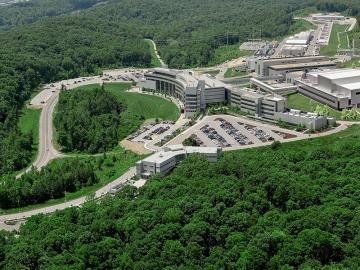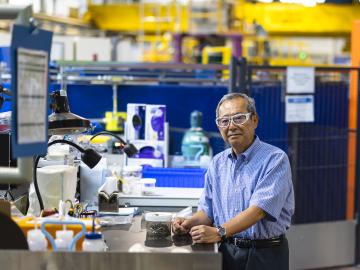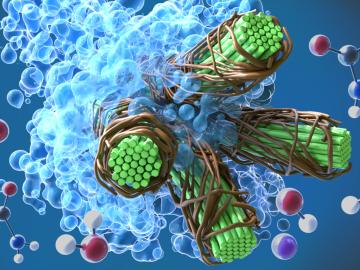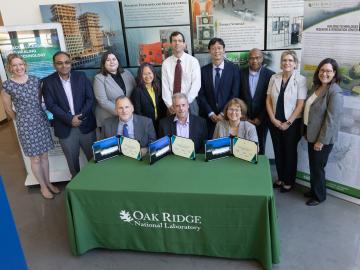
Filter News
Area of Research
- Advanced Manufacturing (6)
- Biology and Environment (15)
- Clean Energy (36)
- Electricity and Smart Grid (1)
- Functional Materials for Energy (2)
- Fusion and Fission (2)
- Fusion Energy (2)
- Isotopes (4)
- Materials (75)
- Materials Characterization (2)
- Materials for Computing (10)
- Materials Under Extremes (1)
- National Security (3)
- Neutron Science (15)
- Supercomputing (42)
News Topics
- (-) Frontier (49)
- (-) Materials (151)
- 3-D Printing/Advanced Manufacturing (133)
- Advanced Reactors (35)
- Artificial Intelligence (107)
- Big Data (66)
- Bioenergy (94)
- Biology (105)
- Biomedical (63)
- Biotechnology (25)
- Buildings (69)
- Chemical Sciences (74)
- Clean Water (31)
- Climate Change (110)
- Composites (32)
- Computer Science (202)
- Coronavirus (46)
- Critical Materials (29)
- Cybersecurity (35)
- Decarbonization (89)
- Education (5)
- Element Discovery (1)
- Emergency (2)
- Energy Storage (112)
- Environment (206)
- Exascale Computing (48)
- Fossil Energy (6)
- Fusion (59)
- Grid (67)
- High-Performance Computing (100)
- Hydropower (11)
- Irradiation (3)
- Isotopes (57)
- ITER (7)
- Machine Learning (55)
- Materials Science (150)
- Mathematics (10)
- Mercury (12)
- Microelectronics (4)
- Microscopy (51)
- Molten Salt (9)
- Nanotechnology (60)
- National Security (76)
- Net Zero (15)
- Neutron Science (143)
- Nuclear Energy (111)
- Partnerships (54)
- Physics (66)
- Polymers (33)
- Quantum Computing (40)
- Quantum Science (75)
- Renewable Energy (2)
- Security (26)
- Simulation (55)
- Software (1)
- Space Exploration (25)
- Statistics (4)
- Summit (63)
- Sustainable Energy (133)
- Transformational Challenge Reactor (7)
- Transportation (99)
Media Contacts

A multi-institutional team of researchers led by the King Abdullah University of Science and Technology, or KAUST, Saudi Arabia, has been nominated for the Association for Computing Machinery’s 2024 Gordon Bell Prize for Climate Modelling.

Researchers led by the University of Melbourne, Australia, have been nominated for the Association for Computing Machinery’s 2024 Gordon Bell Prize in supercomputing for conducting a quantum molecular dynamics simulation 1,000 times greater in size and speed than any previous simulation of its kind.

Researchers have developed and 3D printed the lightest crack-free alloy capable of operating without melting at temperatures above 2,400 degrees Fahrenheit, which could enable additively manufactured turbine blades to better handle extreme temperatures, reducing the carbon footprint of gas turbine engines such as those used in airplanes.

To bridge the gap between experimental facilities and supercomputers, experts from SLAC National Accelerator Laboratory are teaming up with other DOE national laboratories to build a new data streaming pipeline. The pipeline will allow researchers to send their data to the nation’s leading computing centers for analysis in real time even as their experiments are taking place.

A new technology to continuously place individual atoms exactly where they are needed could lead to new materials for devices that address critical needs for the field of quantum computing and communication that cannot be produced by conventional means.

The Oak Ridge Leadership Computing Facility welcomed users to an interactive meeting at the Department of Energy’s Oak Ridge National Laboratory from Sept. 10–11 for an opportunity to share achievements from the OLCF’s user programs and highlight requirements for the future.

ORNL's Spallation Neutron Source, the nation’s leading source of pulsed neutron beams for research, was recently restarted after nine months of upgrade work.

Distinguished materials scientist Takeshi Egami has spent his career revealing the complex atomic structure of metallic glass and other liquids — sometimes sharing theories with initially resistant minds in the scientific community.

A team led by scientists at ORNL identified and demonstrated a method to process a plant-based material called nanocellulose that reduced energy needs by a whopping 21%, using simulations on the lab’s supercomputers and follow-on analysis.

Flexcon Global has exclusively licensed two patented inventions to manufacture a self-healing barrier film from ORNL for research and development purposes. The film can be incorporated into vacuum insulation panels to increase the efficiency of buildings during retrofits. Under a cooperative research and development agreement that began in 2021, Flexcon and ORNL have been exploring the capabilities of the technology and fine-tuning its properties.


